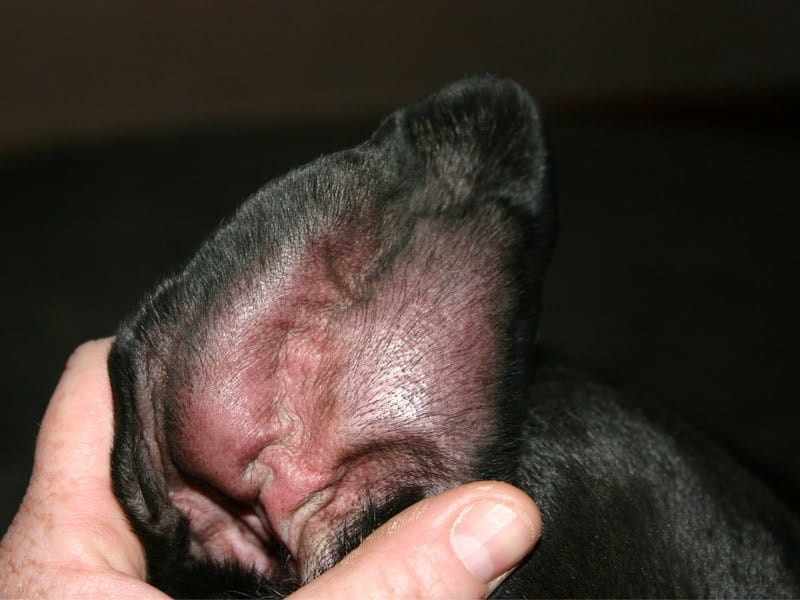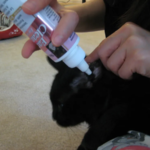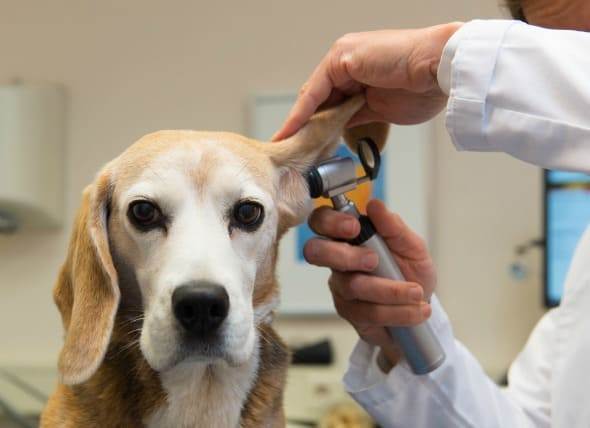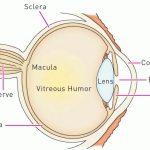Dogs seem to get ear infections with more frequency than expected and some dogs deal with almost ongoing ear infections. Compared to human ear infections, dogs have trouble at a much higher rate. There are a couple of reasons why: the shape of the ear canal and the common frequency of conditions leading to excess ear wax.
The first problem for the dog’s ear is structural. The dog’s ear canal has both a vertical and a horizontal section. This “L” shape predisposed a dog to ear infections as debris must work its way upward rather than straight out. If ear wax cannot get out, it builds up. Accumulation of ear wax, skin oil, and other debris feed the bacteria and fungi that live in the normal ear canal leading them to proliferate. Soon an infection results.
Anything that facilitates ear wax accumulation, sets the stage for ear infection. It might be the narrowed ear opening of certain breeds further hampering ear drainage, irritation from water in the ear canal after a bath or actual disease causing over-production of ear wax. Allergic skin disease affecting the ears is another common cause for recurring increased ear wax production/ear infection; other causes of ear infections include ear mites, and foreign bodies in the ear (such as grass awns or foxtails), or hair growth deep in the canal (common in poodles and schnauzers especially). The moisture of the wax promotes bacterial growth, yeast proliferation, and perhaps even pus development.
It isn’t long before the pet is seen scratching at his ears, shaking his head or holding one ear slightly dropped. Discharge and odor may be noticeable to you.
Complications of Ear Infection
Aural Hematoma
When a dog with uncomfortable ears shakes and scratches vigorously, a blood vessel in the earflap may rupture. This leads to bleeding into the tissues of the pinna (ear flap). The usual recommendation is to have the blood clots removed and the ear bandaged and cleaned under anesthesia. If the hematoma is not so big as to occlude the ear canal (thus preventing medication of the ear canal), the option to forgo surgery exists; but without surgery, the ear may scar down into an abnormal appearance.
Proliferative Ear Canal Change and Middle Ear Infection
A routine ear infection is uncomfortable enough but if the infection persists, it can become an even bigger problem. The infection can lead to proliferation and scarring in the canal which makes the infection especially difficult (and potentially impossible) to clear up. The ear canal may mineralize and the middle ear may come to be involved, leading to nerve damage. Affected animals may have a head tilt, a lack of balance, and unusual back-and-forth eye movements (called nystagmus.) These symptoms are called vestibular signs and represent a complication of middle ear infection. Middle ear infections can also cause paralysis of the facial nerve, leading to a slack-jawed appearance on that side of the face.
Severe cases may require surgical intervention to remove the vertical portion of the ear canal (lateral ear resection) or even remove and seal the ear canal (ear canal ablation). It is important to control ear infections before they reach this stage if at all possible.
While ear infections can be challenging and are all too common, most cases are simple and easily cleared. But be sure to recheck the ears as your veterinarian recommends as premature discontinuance of treatment can lead to a continuing infection.
Treatment
Level One: The Simple Ear Infections
Most ear infections are cleared up simply with professional cleaning followed by medication at home. If only mild debris is present in the ear canals, simple disinfection and washing of the ear is adequate; however, in many cases, a full ear flush is needed to even examine the eardrum. For patient comfort, we recommend sedation for this procedure as the ears are sore and the instruments can be damaging if the pet jumps at the wrong time. A sample of ear discharge is commonly examined under the microscope so as to assist in selecting medications for home use. After a couple of weeks of home treatment, the ear canals are rechecked to be sure the infection is gone. In most cases this completes treatment but for stubborn cases, we must proceed to the next step.
Level Two: On-Going Ear Infections
Some dogs have chronic ear problems (the infection is not controlled by general medication or returns when general medication is discontinued). In these cases, the ear discharge should be cultured so that the precise organism can be pinpointed and treated specifically. Regular treatment at home with disinfecting ear washes should become part of the pet’s grooming routine.
Further testing may be in order to determine why the infection continues to recur. Allergy is the most common reason for recurrent ear problems but hormone imbalances can also be underlying causes.
Level Three: The End-Stage Ear
Some ear infections simply cannot be controlled with the above steps. These cases have gone beyond medical management and must proceed to surgical management. What this entails will depend on the state of the ear canal. Your veterinarian will make recommendations accordingly.
Chronic inflammation has led to proliferation of ear tissue.
Ear infections are common and can be challenging. Fortunately, most cases are simple and easily cleared up. Be sure to recheck the ears as your veterinarian recommends as premature discontinuance of treatment can lead to a continuing infection.
Urban Animal Veterinary Hospital
1327 Yale St
Houston, TX 77008
(713) 863-0088



